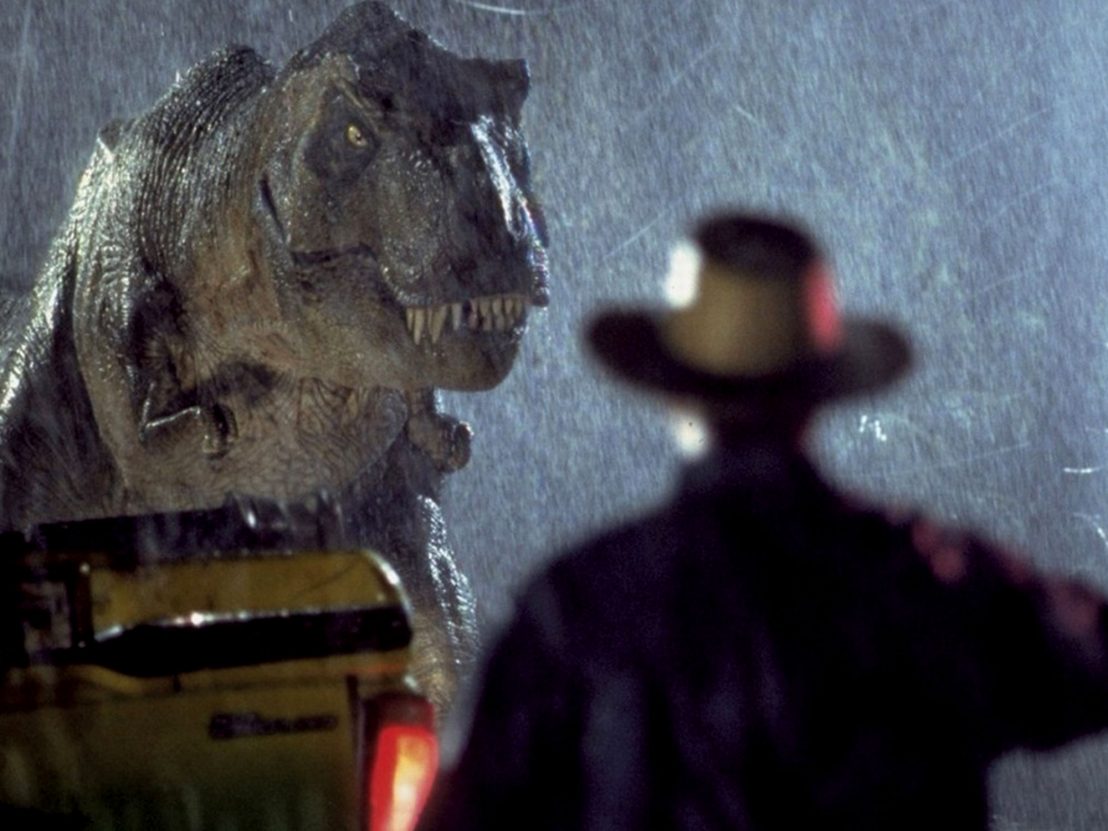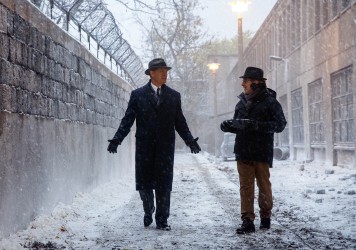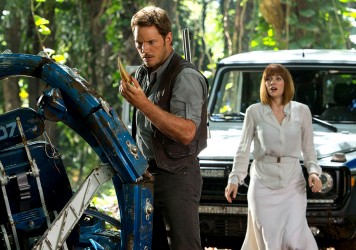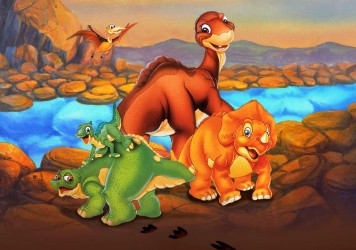
One sub-strand of popular criticism that interests me greatly is when someone claims to have “a theory” about a movie. It’s generally some kind of crackpot reading which might not warrant being delicately chipped into that cultural marble tablet we call the internet so that it may be pored over by wide-eyed ascendants as the consensus view of a bygone, possibly happier age. It’s more an off-hand imposition that might rear its head around midnight after a few sweet sherries, to be all-but-dismissed as dilettantish whimsy by sun-up. A movie like Stanley Kubrick’s The Shining remains perhaps the ne plus ultra of the “theory” movie as, by design, anything you throw at it sticks in some way, shape or form.
I have a theory about the 1993 feature Jurassic Park, directed by Steven Spielberg. The film was made concurrently with the “serious” prestige picture, Schindler’s List, a work which took the bold, ethically controversial step of actually taking cameras inside the gas chambers (or, a movie reconstruction of said) in an attempt to depict their profound horrors for a new generation.
I mention this by way of bolstering the magnificent logistical juggling act undertaken by Spielberg, not as a way to superficially compare the films as two dovetailing visions of the apocalypse, one rooted in reality, the other in fantasy. Yet, both films are loosely concerned with Darwinian superiority, Schindler’s List presenting a corruption of that theory to achieve nefarious ends, Jurassic Park presenting a group of humans believing they can disprove the theory in the name of high-tax-bracket immersive theatre. Or, as it’s referred to in the film, “playing god”.
Having been born at the very front end of the ’80s, I was a boy who came of age in tandem with that fateful long weekend when an ill-fated duo of gung-ho palaeontologists were packed off to Isla Nublar to help a doddery Scottish entrepreneur get his new-fangled theme park signed off by The Lawyers. It’s rare to read a piece on Jurassic Park which isn’t tinged with dewy-eyed nostalgia, like the film’s quality is because of, not despite the fact that it was, for so many, a formative cinematic experience which really showcased the arsenal of creative tools available to filmmakers who were entrusted with inordinate coffers of cash. Maybe that’s too cynical a way to put it, but it was for this writer one of the first films that I could walk away from and honestly say to myself, ‘Well, that was new…’
On a purely personal level, Jurassic Park was important to me as I think it’s the first time in my life I can remember being physically scared of something. I’m certain, at 13, there would’ve been plenty of things in the past that had given me the willies for some reason or other, but at a preview screening at the now-defunct UGC Trocadero – with its famous Roman-themed art panels lining the main escalator which one would ride to the heavens – I recall for the first time banking in my mind what fear actually felt like. The other reason that Jurassic Park was important to me was because it was the first time I started to take vague notice of this marginal and rarified activity known as film criticism or, as I would term it back then, “the reviews”.
Of those voicing their opinions in some kind of public forum, I distinctly recall Empire magazine giving the film a very volatile five-star review, essentially dismissing it as cliché-riddled and with a “bad script” and “bad acting”, but that none of that mattered because oh man, oh man, oh man T-Rex running! oh man, oh man… Yes, the imaginative effects were the sole reason to place this one on the viewing docket.
Even my history teacher of the time spent the introduction to one lesson outlining what he considered to be the film’s ugly flaws, only currying favour back with the room by doing an amusing impression of a wading Brachiosaurus, replete with puffed up cheeks and mock timpani drum footsteps, prior to returning to work on the Mai Lai Massacre. (I recall in a later lesson he admitted to liking the film Nothing But Trouble from 1991, so maybe this is all to be dismissed as proto trolling?).
Back then, I couldn’t see any problems with the film and, to this day, I still don’t. What were other people seeing that I couldn’t? Were they bothered by the fact that Richard Attenborough’s bonny Highlands accent falls by the wayside in the final act? Were the kids deemed too icky and annoying for their survival to count as an emotional positive? Was Sam Neill really the taciturn Indiana Jonesian hero we were all waiting for? This wasn’t something that irked me for much time. And, if it irked me at all, is was because I couldn’t comprehend the criticisms, not that there were people dispensing barbs at something I was fond of.
Like a favourite snack food, Jurassic Park was a film I consumed voraciously in the interim years without ever once stopping to think why I was so happy to keep returning to it. Jurassic World is forthcoming, a belated sequel which, like the Alien franchise, seems set to prove that when it comes to weaponising flesh-eating monsters (or placing them into the entertainment industry), corporate America just doesn’t know when it’s beat. For that reason, I decided to give the old girl a re-watch, just because I was certain that this new movie would play like a nerd culture homage to the first one, and I’d want to have my reference-hunting capabilities fully in tact.
Yet, seeing Jurassic Park again, I was furnished with a very different film to the one I’d known and loved. For so long I’d thought this film was – to rake up an anaemic metaphor from a previous graf – a junk food movie, something with no real nutritional value, like the sugar-coated contents of Dennis Nedry’s coding marathon pick-me-up draw. Only now did the implacable beauty of its construction and execution begin to reveal itself. This here was in fact a hearty banquet, a cornucopia of exotic and colourful foodstuffs, akin to the pristine buffet dinner happened across and consumed by scarred-for-life pre-teens, Tim and Lex Murphy (Joseph Mazzello and Ariana Richards). It’s that moment when your palate suddenly detects untapped depths and richness in something that the rest of your body is signalling as boringly familiar. It was revelatory.
Jurassic Park is, for want of a better term, a self-aware blockbuster. Like the raptors, it has far more intelligence and wile than we may have given it credit for. It’s a movie which tells the story of its own production. And not only its own production, but the ensuing history of mammoth effects movies. Until its inception, computer effects in movies were mere cosmetic spectacle. Movies were a reason to innovate in that field. The movies came first, then the effects came afterwards.
Yet there was a Brechtian, destabilising effect to their inclusion in a film because you were instantly reminded that you’re watching a movie, that it’s an expressionistic reflection of reality. There will of course be exceptions to this rule, earlier films whose effects manage to dazzle the eye into a state of disbelieving wonderment. Yet what makes Jurassic Park special is that the quality of its effects are what prevent it from being pigeonholed as a fantasy movie. Indeed, it’s the actors, acting and talking like actors act and talk, which implicitly remind the viewed that it’s only a movie. Even magical realism doesn’t quite cover it. Jurassic Park is romantic realism.
Watch it again, and think of the dinosaurs as spectral embodiments of CGI. Spielberg himself is John Hammond, the safari-suited dreamer who has discovered the formula to bring a once-extinct species back into being. The mosquito trapped in amber, from which the “dino DNA” has been preserved and is extracted, is itself the CG-sheen which adds that special something to the latex and clock-parts “frog DNA” which are ushered in to complete the experiment. On their own, they are two separate, immutable constituents (one biological, the other technological), but together they form something we can barely comprehend. It’s a cinematic atomic fusion, the marriage of divergent matters to produce something else, something new.
Spielberg and George Lucas have talked of their feelings when they saw the initial digital test shots of the dinosaurs, with the latter commenting, “it was like one of those moments in history, like the invention of the light bulb or the first telephone call… A major gap had been crossed and things were never going to be the same.” Having seen the film, we can attest that this wasn’t just hyperbolic self-love.
This instance of private awe went on to be recreated in the film itself, at the moment where doctors Alan Grant (Neill) and Ellie Sattler (Laura Dern) first lay their eyes on one of the revivified creatures from the helm of a Land Rover. Dern’s split-second gaze, which switches on a dime from total disbelief to unalloyed, slack-jawed astonishment, from heightened normalcy to transcendent stupefaction is, for me, one of the two or three greatest shots that the neon sewage system we call cinema has spewed to the surface amid its squalid backwash over the last century or so. Spielberg posits that seeing a dinosaur that has been fabricated by modern man – a feat he himself has achieved in the making of this movie – is no different from seeing a synthetic, computer-assisted version of the same. Ellie the sceptic has been beguiled.
I don’t want to run this theory into the ground by boorishly detailing all the moments which bolster its “integrity”, but you could consider some of the following: that Dennis Nedry’s furtive paymasters, the ones bribing him into stealing frozen DNA samples for their own experimentation are representative of a rival studio attempting to stay ahead of the techno-curve; that this technology can be minutely calibrated. I’ve always loved the off-hand line by John Hammond, “Well, we clocked the T-Rex at 32 miles an hour.” You could read this as the scientists of Jurassic Park measuring how fast it can run by simple observation. Or, that they’ve somehow tinkered at a fundamental biological level and actually decided themselves that this is how fast this creature will be able to run. The fact that the speed at which a living being is able to run cannot be prescribed by invasive action is a reminder that these dinosaurs have been entirely sculpted by man.
As anyone familiar with disaster movie lore will know, things don’t go quite as planned for the first tranche of guests at Jurassic Park, with Grant eventually stating that he won’t be rubber-stamping this particular family enterprise. It’s a note which dryly pre-figures the sniffy reviews. It’s interesting, however, that so much of the film is about volatility, about not realising that creating something is an entirely different process to controlling it. “Life finds a way,” is how it’s expressed by Hammond as a way to surmise the success of his genetically-powered folly, again alluding to the idea of natural selection and animals prolonging their species bloodline by physically adapting to indifferent natural surroundings.
Yet later, when recently hatched eggs are discovered by Grant and the kids, despite being told that all the animals in the park were the same sex, he utters the line once more, this time lending it a more sinister timbre. If life always does “find a way,” then the notion of continued human dominance is precarious at best. When will the CG develop a life of its own? Will movies even need human beings any more?
CGI also finds a way, and after Jurassic Park’s runaway box office success, this brand of movie was to become the norm at multiplexes the world over. As far as where this “theory” goes from here, you can take it and run with it in whichever direction you please. The human contingent abandon the island and the computerised monsters begin to assert their dominance over one another. Good breeding might suggest a knee-jerk cut-and-run, drop a big ol’ nuke on the location and draw a line under what should perhaps be considered a failed experiment. We can’t have nice things. But what the dinos – and CG – did next was that they multiplied swiftly, and they began to terrorise humanity on a near-monthly basis. The question of whether we could or should became moot, as it became a question of how quickly, and what it would cost to scale it up to the next feasible level.
A school friend of mine had his own “theory” about Jurassic Park, a speculation which pertained more to how the saga would likely play out through its sequels rather than a grand allegorical reading of the first instalment. It relates to the (tragic?) death of Dennis Nedry, blinded then (we assume) bitten to death in his jeep by the peacock-like Dilophosaurus. He’s en route to delivering a cachet of purloined DNA samples to a stooge from a competing company, the phials having been hidden within a (now iconic) can of Barbasol shaving foam.
Spielberg ominously swings the camera away from Nedry’s unseen death throes and tracks down to the red-and-white striped canister which now lays abandoned in the undergrowth. The torrential rain brings on a sluice of mud and – like a fossil – its submerged in the ground. My pal was certain that the shaving foam was the key to the future, that some kid was going to happen across it and start his own dino park. It never happened. But I remain hopeful, still waiting for some intrepid soul to unearth it and use its contents to make something that’s as beautiful and beguiling as Jurassic Park.
Published 1 Jun 2015

We take stock of the (almost) complete oeuvre of one of modern cinema’s true masters.

Silly self-reflexivity dominates in Colin Trevorrow’s noble attempt to sell CG dinos to a jaded modern audience.

In the wake of his untimely death, we remember James Horner’s vital contribution to this family classic.